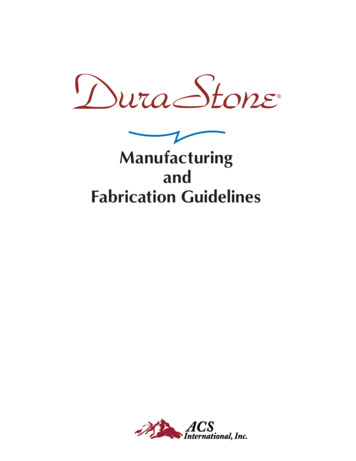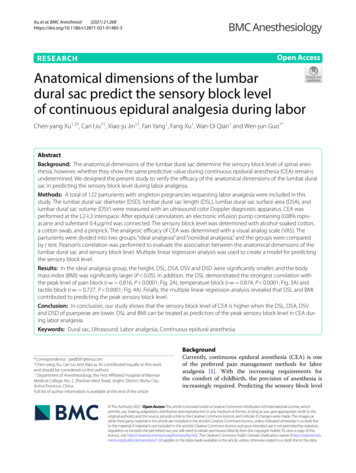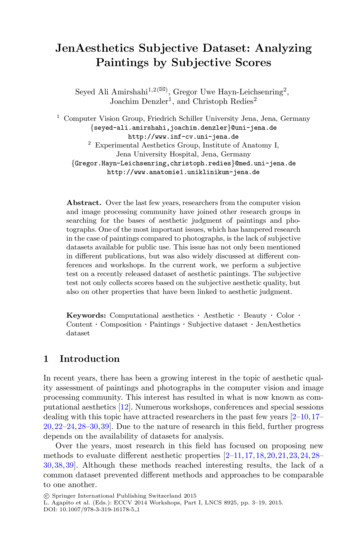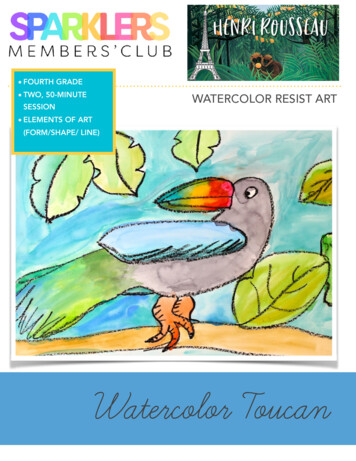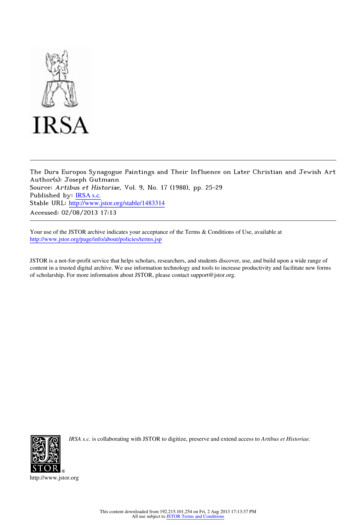
Transcription
The Dura Europos Synagogue Paintings and Their Influence on Later Christian and Jewish ArtAuthor(s): Joseph GutmannSource: Artibus et Historiae, Vol. 9, No. 17 (1988), pp. 25-29Published by: IRSA s.c.Stable URL: http://www.jstor.org/stable/1483314 .Accessed: 02/08/2013 17:13Your use of the JSTOR archive indicates your acceptance of the Terms & Conditions of Use, available at ms.jsp.JSTOR is a not-for-profit service that helps scholars, researchers, and students discover, use, and build upon a wide range ofcontent in a trusted digital archive. We use information technology and tools to increase productivity and facilitate new formsof scholarship. For more information about JSTOR, please contact support@jstor.org.IRSA s.c. is collaborating with JSTOR to digitize, preserve and extend access to Artibus et Historiae.http://www.jstor.orgThis content downloaded from 192.215.101.254 on Fri, 2 Aug 2013 17:13:37 PMAll use subject to JSTOR Terms and Conditions
JOSEPHGUTMANNThe Dura Europos Synagogue Paintings and their Influenceon LaterChristianand Jewish Art*The third-century Dura Europos synagogue paintingsrepresent the earliest continuous narrative cycle of biblicalimages known in art. Not until the fifth century do we findsimilar complex and elaborate narrative cycles of biblicalimages in church art.Since the Dura synagogue paintings are the earliestcontinuous surviving narrative biblical cycle, they havenaturally raised the question of whether there exists arelationship between them and later biblical scenes found inmedieval Jewish and Christian art. No systematic study hasbeen devoted to this problem, but scholars have occasionallyattempted to compare certain narrative scenes appearing in theDura synagogue paintings with those found in later Christianand Jewish art.One such comparison involves the Dura synagoguedepiction of a nude figure standing in the water and holding achild [Fig. 1]. The figure has been identified as the Egyptianprincess standing in the Nile, rescuing the child Moses. Sincethe nude princess in the waters is also found in several medievalJewish and Christian miniatures dating from twelfth- tofourteenth-century Spain, some scholars have posited a directconnection between the Dura synagogue painting and themedieval Spanish illustrations. However, this need not be thecase. The Dura synagogue painting appears to be closelyrelated to such sources as the contemporary Targumim(Aramaic paraphrases of the Hebrew Bible), which clearlyexplain that the princess, suffering from leprosy, went downto bathe in the Nile and was miraculously cured of her afflictionwhen she touched the basket containing the child Moses. Themedieval Spanish depictions usually reveal three or four nudefigures in the water, but in only one miniature [Fig. 2] is a nudefigure labelled "Tarmuth" (a name for the princess found inearly sources like Josephus and repeated in later texts). Theinscription on this miniature further explains that"the daughter of Pharaoh [accompanied by] her maidenscleanses herself [in the Nile]."Iconographically, the medieval illustrations do not show threeclothed maidens awaiting the princess on shore, and the childis not held aloft by the princess, as is the case in the Durasynagogue painting. Furthermore, the Dura painting and themedieval Spanish miniatures appear to be influenced bydifferent literary traditions.1Scholarly attempts to link the rendition of the Sacrifice ofIsaac in the Dura synagogue with depictions in Spanish art areequally unconvincing. The Leon Bible of 960, fol. 21v, forinstance, shares with the Dura painting only the element ofIsaac lying atop the faggots on the altar. In the Leon Biblescene Isaac and Abraham are shown facing the viewer ratherthan with their backs to the spectator as in the Dura synagogueversion [Figs. 3-4]. Moreover, the ram at Dura is standing nextto a tree, while in the Leon Bible it is entangled in the thicket,in keeping with the biblical narrative. Although the hand of God(rather than the angel) is revealed in both depictions, the LeonBible has the hand bestowing the Christian benediction (thebenedictio latina). In addition, Abraham uses a knife in Dura,while in the Leon Bible Abraham uses a sword (the more25This content downloaded from 192.215.101.254 on Fri, 2 Aug 2013 17:13:37 PMAll use subject to JSTOR Terms and Conditions
.,.*i-W:9t"'*Y?''1) ((The Findingof Moses", Dura EuroposSynagogue, west wall, Syria, ca. 245 A.D., Damascus National Museum.common implement featured in Christian art). Furthermore,Abraham's grasping of Isaac's hair in the Leon miniature is adetail not found in the Dura painting.Thus the tenth-century Leon Bible miniature appears todiffer too greatly from the Dura synagogue painting to beconsidered dependent upon it.2The analogies that have been drawn between some scenesin the eleventh-century Spanish Ripoll Bible and the Durasynagogue depictions do not prove a direct connectionbetween them. The only similarity in the illustrations of Hamanand Mordecai in the Dura painting and in the Ripoll Bible(Biblioteca Vaticana, MS lat. 5729, fol. 310v) is that Hamanis leading Mordecai's horse. There are, however, significantdifferences. In the Dura synagogue scene there are threefigures with arms raised in a gesture of acclamation; in theRipoll Bible we find four. Moreover, the four figures are behindthe horse in the Ripoll Bible, rather than in front of the horseas at Dura. Furthermore, the Ripoll Bible figures are notpresented frontally, as at Dura, and, in addition, their garmentsdiffer radically.3 Close stylistic and iconographic parallels tothe Haman and Mordecai scene of the Dura synagogue can befound in the roughly contemporary sculptural reliefs fromPalmyra.4On folio 82 of the Ripoll Bible the illustration of the Crossing26This content downloaded from 192.215.101.254 on Fri, 2 Aug 2013 17:13:37 PMAll use subject to JSTOR Terms and Conditions
3) ((The Sacrifice of Isaac)), Dura Europos Synagogue, westwall, Syria, ca. 245 A.D., Damascus National Museum.2) ((The Finding of Moses), Pamplona Bible, Spain, ca. 1200,Harburg, Collection Prince Oettingen-Wallerstein, MS I, 2,lat. 4, fol. 49.of the Red Sea [Fig. 5] bears an interesting iconographicsimilarity to the same theme in the Dura synagogue. In bothinstances we see the hand of God, armed Israelites and nakedEgyptian bodies drowning in the water. However, there neednot be a direct connection between these two renderings, sincereferences to armed Israelites and naked Egyptians drowningcan be found in both Jewish and Christian literary traditions.5Narrative scenes in the Dura synagogue paintings have beenlinked not only with Spanish illustrations, but with Byzantineones as well. Such depictions as that of Jacob blessing thesons of Joseph in the Dura synagogue have been compared4) (The Sacrifice of Isaac,), Leon Bible, Spain, 960, Leon, Colegiata de San Isidoro, Cod. 2, fol. 21v.27This content downloaded from 192.215.101.254 on Fri, 2 Aug 2013 17:13:37 PMAll use subject to JSTOR Terms and Conditions
5) (The Exodus from Egypt,MS lat. 5759, fol. 310v.Ripoll Bible, Spain, first half of 11th century, Vatican City, Biblioteca Apostolica,with Byzantine Octateuchs (for instance, Istanbul, TopkapiSaray Library, Cod. gr. 8, fol. 141), yet the similarities arerather superficial. In both renderings the four major personsdescribed in the Bible are present, and the patriarch is seenreclining. However, the costumes in the two scenes differ. Inthe Dura synagogue painting Joseph is clad in a Persiantrousered costume, whereas in the Octateuch he is shownwearing the draped robe. Furthermore, in the Dura paintingJacob is neither bearded nor has white hair, as in the Octateuchminiature. In addition, in the Dura scene neither Jacob norJoseph are haloed, as they are in the Octateuch rendition. Inthe Octateuch all of the figures are shown in profile, while atDura they are presented frontally. Moreover, in the OctateuchJacob's hands are shown crossed, an antitype of Jacob'spreference for his younger son Ephraim (interpreted by theChurch Fathers as Ecclesia). The Dura depiction seems to haveavoided the crossing of Jacob's hands - the prefiguration ofthe cross.6 It seems, then, that the differences in the twoscenes far outweigh the resemblances, and appear to rule outany direct connection between them.Such is also the case in the comparison between theDestruction of the Temple of Dagon miniatures in the eleventhcentury Book of Kings (Biblioteca Vaticana, MS gr. 333,fols. 9v-10) and the scene in the Dura synagogue. The Bookof Kings miniatures follow the biblical narrative of theSeptuagint and render the ark-box with cherubim, but in theDura synagogue painting we see the Torah ark-chest - apurposeful substitution to indicate that the illustration is relatedto contemporary Palestinian liturgical synagogal practices andtexts. Thus, while there may be some similarities in thedepiction of the idols in the double arcade and in the exteriorand interior views of the Dagon Temple, the reliance ondifferent textual traditions, the rendering of different arks andthe diverse costumes worn augur against claiming a directrelationship between the Dura painting and the Book of Kingsminiatures.7It should be stressed that the Dura synagogue and its cycleof paintings was buried as part of the Roman defense systemagainst Sasanian attacks, which occurred around 256 A. D.During the short period of time preceding their burial it isunlikely that they exerted an influence on later Christian art.It has been suggested recently that models for the Durasynagogue paintings may have existed in a synagogue in alarger nearby center, such as Palmyra. It should be noted,however, that even if that were true, they could not haveexerted an influence on Christian art, either, as Palmyra wassacked by Rome around 272 A. D.8It seems evident from all the scenes discussed herein thatno concrete and indisputable connection can be establishedbetween the illustrations in Christian and Jewish art and thepaintings at the Dura synagogue.9 The parallels cited byscholars are too problematic to be convincing.28This content downloaded from 192.215.101.254 on Fri, 2 Aug 2013 17:13:37 PMAll use subject to JSTOR Terms and Conditions
* I am deeply indebted to Dr. MarilynGutmannfor reading thispaper and making many suggestions for its improvement.1 J. Gutmann, "Josephus' Jewish Antiquitiesin Twelfth-CenturyArt:Renovatioor Creatio?,"ZeitschriftfurKunstgeschichte,48, 1985,pp. 435-438; idem, "The IllustratedMidrashin the DuraSynagoguePaintings: A New Dimension for the Study of Judaism," AmericanAcademy for Jewish Research Proceedings, 50 (1983), p. 94.Cf. T. Gaster, "A SamaritanPoem about Moses," The Joshua BlochMemorialVolume (ed. A. Berger,et. al.), New York, 1960, pp. 120,125. Cf. also K. Schubert, Bilder-Pentateuch von Moses dalCastellazzo, Venice, 1521, Vienna, 1985, pp. 114-115, for anotherversion of the nude princess andthree of herhandmaidens(on fol. 73).This scene appears to follow the similardepiction in the fourteenthcentury Kaufmann Haggadah, fol. 10; Gutmann, "Josephus'Antiquities.," op. cit., p. 437, n. 13.2 J.Gutmann, "The Sacrifice of Isaac: Variationson a Theme inEarlyJewish and ChristianArt," Thiasos ton Mouson: Studien zuAntike und Christentum. Festschrift fOrJosef Finkzum 70. Geburtstag (ed. D. Ahrens), Cologne, 1984, pp. 118-119; idem, "The DuraEuropos Synagogue Paintings: The State of Research," TheSynagogue in Late Antiquity (ed. L. I. Levine), Philadelphia,1987,p. 69, no. 1.3 C. Walter, "Papal Imagery in the Medieval Lateran Palace,"Cahiersarch6ologiques, 21, 1971, pp. 130-131.4 H. J. W. Drijvers,TheReligionof Palmyra,Leiden,1976, pls. LXVIand LXIX/1,pp. 25, 28.5 Gutmann, "Illustrated Midrash.," op. cit., pp. 102-103;C. H. Kraeling,TheSynagogue (TheExcavationsat DuraEuropos,FinalReport, 8/1), New Haven, 1956, pl. LIIIl,p. 83; L. Ginzberg, TheLegends of the Jews, Philadelphia,1947, VI, p. 55, no. 11 (EliyahuRabbah 1:2 mentions that God punishes the wicked while naked andEstherRabbah3:14 relates that "The Egyptianswhen they sank in thesea were also punished naked"). Cf. H. Kunz, Materialien undBeobachtungenzur Darstellungder Lotgeschichte (Genesis 19, 12-26)von den Anfangen bis gegen 1500, Munich, 1981, p. 109, who citesChristiansources which indicate that in the MiddleAges nakednesswas an outer sign of sin and guilt. Since the Egyptianswere a sinfulpeople they are depicted naked and thus deprived of spiritualmerit.6 K. Weitzmann,"The Questionof the Influenceof Jewish PictorialSources on OldTestament Illustration,"No GravenImages: Studies inArt and the Hebrew Bible (ed. J. Gutmann), New York, 1971,pp. 77-78; cf. W. Stechow, "Jacob Blessing the Sons of Joseph fromEarly ChristianTimes to Rembrandt,"No Graven Images, op. cit.,p. 262, LXI, and R. Haussherr, RembrandtsJacobssegen. Uberlegungen zur Deutung des Gemaldesin der Kasseler Galerie,Opladen,1976, pp. 30-32. D. Korol,Die fruhchristlichenWandmalereienausden Grabbautenin Cimitile/Nola,Munster, 1987, pp. 109-129, reexamines this Durasynagogue paintingand questions interpretationsbased on the assumption that Jacob is not crossing his hands.7 Weitzmann,op. cit., pp. 312-315; J. Gutmann,"The IllustratedJewish Manuscriptin Antiquity:The Present State of the Question,"No GravenImages., op. cit., p. 239, n. 19.8 Gutmann,"Dura EuroposSynagogue.," op. cit., pp. 66-69.9 The connections I cited between the Durasynagogue paintingsandthe AshburnhamPentateuchminiatures(J. Gutmann,"The JewishOrigin of the Ashburnham Pentateuch Miniatures," No GravenImages., op. cit., pp. 329 ff.) should be correctedin the lightof a newstudy by F. Rickert, Studien zum Ashburnham Pentateuch, Bonn,1986. Rickertconvincinglyshows that the AshburnhamPentateuchis a Christian liturgical manuscript and that "Die Beziehungen zujudischen Darstellungenbesteht lediglich darin, dass auch diese ausdem antiken Formenvorratsch6pften," p. 85).29This content downloaded from 192.215.101.254 on Fri, 2 Aug 2013 17:13:37 PMAll use subject to JSTOR Terms and Conditions
The Dura Europos Synagogue Paintings and their Influence on Later Christian and Jewish Art* The third-century Dura Europos synagogue paintings represent the earliest continuous narrative cycle of biblical images known in art. Not until the fifth century do we find similar complex and elaborate narrative cycles of biblical




